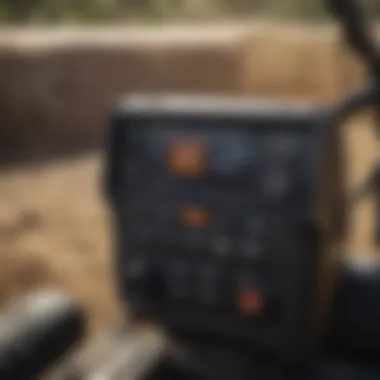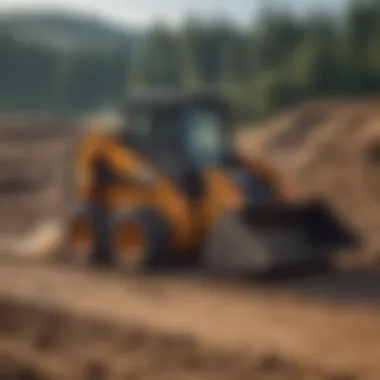Cost Evaluation for New Skid Steers: Key Factors


Intro
In the realm of agricultural machinery, skid steers represent a crucial investment for farmers and enthusiasts. These versatile machines facilitate a wide array of tasks across various sectors. Understanding the financial implications of acquiring a new skid steer is essential for making informed purchasing decisions. This article delves into several factors that influence the pricing of skid steers, with a focus on base costs, additional features, financing options, and market trends. Moreover, we will evaluate how brand reputation shapes buyer choices in this competitive market.
Latest Trends in Agriculture
Overview of Current Trends
The agricultural industry is currently witnessing a transformation fueled by advancements in technology and shifting consumer demands. Skid steers have evolved significantly, integrating features that enhance productivity, efficiency, and ease of use. Farmers today prioritize not only the cost of equipment but also its overall impact on farm operations.
Impact of Technology on Farming Practices
The infusion of technology into skid steers is a game-changer. Many new models feature GPS, automated systems, and IoT capabilities, which allow for precise operation and data collection. These high-tech features can lead to more efficient land usage and reduced operational costs over time. By adopting these modern machines, farmers can improve crop yields and minimize waste, ultimately contributing to a more sustainable agricultural practice.
Evaluating the Base Costs of Skid Steers
When assessing the acquisition cost of a new skid steer, it is critical to recognize the base price as the foundation for your budget. Base prices vary significantly based on the manufacturer and model. Factors such as engine power, lifting capacity, and attachment compatibility heavily influence these costs. Take note that an entry-level skid steer may range from $20,000 to over $50,000, depending on the specifications and added features.
"The base cost is just the beginning. Understanding the full financial picture is crucial for farmers."
Additional Features and Their Impact on Pricing
Investing in a skid steer often includes several essential and optional features. For instance, enhanced hydraulic systems, improved cab comfort, and specialized attachments can add to the purchase price. While these features may require an upfront investment, they can greatly enhance functionality.
Key Features to Consider
- Hydraulic Performance: Higher flow rates can increase productivity.
- Operator Comfort: Adjustable seats and climate control can reduce fatigue.
- Attachment Variety: A range of attachments increases versatility for different tasks.
Understanding these elements can help you make an informed decision about which model aligns best with your operational needs.
Financing Options for Skid Steers
Navigating financing can be intimidating. However, various options are available that can ease the financial burden of a new skid steer. Many dealers provide financing plans that include competitive interest rates. Furthermore, agricultural grants and loans may be available from local and federal programs. Popular financial institutions also specialize in agricultural financing, offering tailored solutions for equipment purchases.
Market Trends and Brand Reputation
The skid steer market is subject to continual shifts driven by industry demand and technological advancements. Keeping abreast of current trends can significantly impact your decision-making process.
Choosing the Right Brand
The reputation of a brand often correlates with the reliability and performance of the machine. Renowned manufacturers like Caterpillar, Bobcat, and John Deere are typically associated with quality and longevity. If your budget permits, opting for reputable brands may result in lower maintenance costs and increased resale value over time.
Finale
Prelims to Skid Steers
Skid steers are versatile machines that serve many purposes in agriculture, construction, and landscaping. Understanding skid steers is vital for anyone considering the purchase of a new unit. These compact, maneuverable vehicles are designed for a range of tasks, from digging and grading to lifting and moving materials. With numerous models on the market, it is essential to carefully evaluate what fits your specific needs.


The importance of analyzing skid steers lies not only in their functionality but also in their cost-effectiveness. Buyers should be aware of the various factors that determine the price, which can vary widely among brands and models. A deep dive into the world of skid steers reveals that the initial investment must be complemented by considerations of maintenance, utility, and potential return on investment. Therefore, understanding how these elements interplay is crucial.
Investing in a skid steer can lead to increased productivity on the farm or construction site. These machines can save both time and effort, enabling operators to complete tasks more efficiently. For farmers, using a skid steer can improve the quality of work and reduce labor costs over time. Thus, the decision to acquire one demands thorough examination and careful evaluation.
There are several key aspects to consider in this section;
- Functionality: Knowing what tasks the skid steer will be used for is critical. This informs not just the choice of machine but also the features required.
- Capacity: Different models have varying weight and lifting capacities, which can greatly affect performance and utility.
- Attachments: Options can include buckets, forks, and augers, influencing both the versatility and cost of the machine.
Understanding Skid Steer Pricing
Understanding the pricing of skid steers is crucial for anyone seriously considering this investment. Skid steers are versatile machines used in many fields, especially in construction and agriculture. The base price can vary significantly, and knowing the factors that affect this cost can help buyers make more informed decisions. A clear grasp of skid steer pricing can save time, resources, and potential frustration later in the purchasing process.
Base Price of Skid Steers
The base price of skid steers typically ranges from $20,000 to over $50,000, depending on the model and brand. This initial price represents the foundation of the financial commitment required when purchasing heavy machinery. Factors such as size, power, and additional features can greatly influence this base price. Therefore, prospective buyers need to assess their needs to find a model that suits their budget without compromising on functionality.
Factors Affecting Skid Steer Costs
Size and capacity
The size and capacity of a skid steer are primary determinants of its cost. Larger machines that can handle heavier loads generally have a higher price point. For example, a compact skid steer may be more affordable, but its limited capacity can restrict its usage in more demanding tasks. When evaluating a skid steer for purchase, the size should match the intended workload. A larger capacity can mean higher productivity, making it a valuable investment for those in need of heavy lifting.
Engine power
Engine power is another critical factor that influences skid steer pricing. Machines with higher horsepower tend to cost more but also deliver improved performance. A more powerful engine can handle tougher terrains and larger attachments. The trade-off often comes in the form of increased fuel consumption, so potential buyers must consider the long-term operating expenses against the initial capital outlay. In evaluating the engine power, one should seek a balance between performance and cost-effectiveness.
Attachments and customization
The ability to customize a skid steer with attachments adds another layer to its cost. Common attachments, like buckets, forks, or grapples, can greatly enhance the machine's functionality. However, they also increase the overall price. Some buyers may prioritize a basic model now and plan for future attachments as budget allows. Customization can lead to better performance tailored to specific job requirements, but it’s essential to plan these expenses within the total budget for the skid steer.
"When evaluating skid steer options, understanding the base price and factors affecting the overall cost can lead to better financial decisions and effective machine performance."
Comparative Pricing: New vs. Used Skid Steers
Understanding the comparative pricing between new and used skid steers is key for anyone looking to make an informed purchase decision. New skid steers often come with the latest features, warranties, and the assurance of reliable performance straight from the factory. In contrast, used skid steers generally offer a lower entry price, appealing to those who may have budget constraints or prefer a more economical solution for their hauling and lifting needs.
In this section, we will look closely at the pricing of used skid steers and assess the benefits and drawbacks of purchasing used equipment. This deeper examination is essential for navigating the often complex terrain of skid steer acquisitions, ultimately ensuring that buyers are well-informed.
Evaluating Used Skid Steer Market Prices
The market for used skid steers can fluctuate based on various elements like age, condition, and demand. When evaluating prices, it's critical to look at similar models from reputable sources to establish a fair market rate. Online marketplaces such as Craigslist, Auction sites, or local equipment dealers can provide valuable insights into current pricing trends.
Key points to consider when assessing used skid steer prices include:
- Model year and brand: Older models typically cost less, but might lack advanced features.
- Operating hours: Equipment with higher hours may have more wear and tear, thus affecting its value.
- Condition and maintenance history: A well-maintained machine will often command a higher price but may be worth the investment in the long run.
"Investing time in research can save you money. Knowing the average price range for used skid steers in your area is crucial before making an offer."
Benefits and Drawbacks of Purchasing Used


Purchasing a used skid steer can provide a range of benefits alongside certain drawbacks.
Benefits:
- Cost savings: The most apparent advantage is the lower cost compared to new models. This can free up budget for other essential machinery or upgrades.
- Depreciation: With used equipment, the bulk of depreciation has often already occurred, which reduces the financial risk associated with your investment.
- Immediate availability: Used skid steers can often be obtained faster than new models. This can be critical when time-sensitive projects arise.
Drawbacks:
- Lack of warranty: Many used skid steers may not come with a warranty, which can lead to higher long-term repair costs if issues arise.
- Potential hidden problems: There is always a risk that used equipment has underlying problems not immediately visible. A thorough inspection by a qualified mechanic is vital.
- Limited customization options: Used skid steers are often sold as-is, which means potential buyers may have to compromise on features or specifications.
Understanding Additional Costs
Financing and Leasing Options
Monthly payments
Monthly payments often serve as a practical approach to financing a new skid steer. Many buyers prefer this option as it breaks down the overall cost into manageable amounts. This is beneficial for those who want to spread their expenses over a period rather than invest a large sum initially. Monthly payments typically feature fixed or variable interest rates that can influence the total cost paid over time.
A key characteristic of monthly payments is flexibility. Manufacturers like Bobcat and Caterpillar often provide tailored financing plans aimed at making payments more accessible for buyers. The unique feature of this financing option is that it allows farmers to maintain cash flow while utilizing the equipment immediately. However, it's crucial to evaluate the interest rates, as they can vary widely and affect the overall financial burden.
Lease terms and conditions
Leasing a skid steer is another option that comes with its own set of lease terms and conditions. This approach can be appealing for farmers who may require the equipment for a limited time. Leasing generally involves paying a fixed monthly rate to use the equipment, which can be a beneficial option for short-term projects. This arrangement provides access to newer models without the commitment of full ownership.
The characteristics of lease terms include conditions related to mileage, hours of operation, and maintenance responsibilities. These factors can impact the overall leasing cost. For example, exceeding the allowed hours might incur additional fees. Lease options often come with lower initial costs compared to buying, yet they may include buyout clauses at the end of the term if ownership is desired. Understanding these provisions can help farmers assess whether leasing suits their operational strategy.
Maintenance and Operating Costs
Routine maintenance expenses
Routine maintenance expenses are another critical aspect of controlling the total cost of owning a skid steer. Regular upkeep is necessary to ensure the longevity and efficiency of the machine. Routine services typically include oil changes, filter replacements, and general inspections. Understanding these costs helps farmers project their yearly expenditures effectively.
A key characteristic of routine maintenance expenses is predictability. Because maintenance schedules are usually standardized, budgeting for these costs becomes a straightforward task. The unique feature is that by investing in regular maintenance, owners can avoid more significant repair costs down the line. While some may view these expenses as burdensome, they should be considered an investment in preserving the machine's operational capabilities.
Fuel consumption rates
Fuel consumption rates significantly impact the operating costs of a skid steer. These rates vary depending on the engine type and efficiency. Farmers often look for machines that offer better fuel economy, especially in regions where fuel prices fluctuate. Understanding fuel consumption is crucial for calculating long-term operating costs.
The key characteristic of fuel consumption rates is their direct correlation with productivity. A machine that runs efficiently can lead to cost savings over time. Farmers need to consider the unique feature of this item, which is that better fuel efficiency not only minimizes operating costs but also contributes positively to environmental factors. However, one disadvantage could be that more fuel-efficient models might carry a higher upfront cost.
In summary, understanding additional costs related to financing, maintenance, and fuel is vital. This knowledge empowers farmers to make informed decisions that align with their operational needs and financial constraints.
Brand Influence on Pricing
The influence of brand on the pricing of a new skid steer cannot be overlooked. In the heavy machinery market, a brand often signifies quality, performance, and reliability. As such, the brand associated directly affects not just the initial cost but also the resale value and operating efficiency of the equipment. Buyers should understand how different brands align with their needs and preferences.
Key elements surrounding brand influence on pricing include:


- Quality assurance: Established brands often have a reputation for delivering high-quality products. This can justify a higher price point as buyers are willing to pay more for perceived value.
- Warranty and support: Premium brands typically offer better warranty terms and customer support. This can be crucial for those who rely heavily on their skid steers for day-to-day operations.
- Market recognition: Brands that are well-known often have a loyal customer base. Recognizable brands might command a price premium simply due to consumer familiarity and trust, which can also save the owner future costs related to maintenance and repairs due to higher quality construction.
Top Brands and Their Pricing Strategies
In the landscape of skid steers, there are several leading brands, each with distinct pricing strategies. Brands like Caterpillar, John Deere, and Bobcat are notable players. Each has developed a niche that supports its cost structure.
- Caterpillar: This brand positions itself at the high end of the market with robust machinery aimed at heavy-duty applications. Prices are generally higher, reflecting durability and advanced technology.
- John Deere: Known for its reliability and extensive support network, John Deere combines competitive pricing with advanced features that appeal to both small farmers and larger construction projects. Pricing is typically mid-range.
- Bobcat: As a frequently preferred brand among small contractors and landscapers, Bobcat has earned a reputation for effective, compact machines. Their pricing strategy appeals to small-to-medium businesses, balancing affordability with versatility.
With these distinctions in strategy, it's essential for buyers to consider not just the cost but also what they are getting for that cost. Opting for a well-established brand can lead to long-term savings despite higher upfront costs.
Brand Reputation Effects
The reputation of a brand significantly influences consumer perceptions and, consequently, pricing. Often, the history and achievements of a brand in the market contribute to its standing among users. Here’s how brand reputation can affect pricing:
- Buyer confidence: A reputable brand instills confidence in consumers. Buyers may be more inclined to invest in a higher-priced skid steer from a trusted brand because of previous positive experiences or feedback from peers.
- Resale value: Equipment from reputable brands often retains its value better over time compared to lesser-known brands. This can result in higher resale prices, offsetting the initial investment costs.
- Performance reliability: Brand reputation is often tied to the reliability of the equipment. Brands known for fewer breakdowns and efficient performance can justify their prices because they minimize potential long-term costs for the owner.
In evaluating the costs associated with a new skid steer, understanding the implications of brand influence is crucial. It not only affects initial expenses but also overall ownership costs and operational efficiency.
Current Market Trends
Understanding current market trends is essential for anyone considering the purchase of a new skid steer. This section aims to highlight the significance of these trends, focusing on both economic factors and technological advancements that are shaping the cost landscape. As the market evolves, multiple elements influence pricing, which can ultimately sway purchasing decisions.
Being aware of these trends helps buyers make informed choices that align with budget constraints and functional requirements. The trends can provide insights into when to buy, what to prioritize in terms of features, and how external conditions might affect what they pay.
Economic Factors Impacting Prices
Economic conditions play a critical role in determining the prices of skid steers. Several factors come into play, including fluctuations in material costs, labor conditions, and broader economic trends.
- Material Costs: The price of raw materials, such as steel and plastics, directly influences production costs. A rise in these raw commodity prices can lead manufacturers to increase the retail price of new skid steers. Monitoring commodity markets can offer early signals regarding potential price changes in skid steers.
- Labor Market: The state of the labor market affects both the manufacturing and service costs. If there are shortages in skilled labor, wage increases may occur, contributing to higher production costs that are passed on to customers.
- Demand and Supply: The balance between supply and demand also affects prices. If a particular model is experiencing high demand but limited supply, expect prices to rise. Conversely, if several units are available without strong demand, costs may be reduced to attract buyers.
Technological Advancements and Their Cost Implications
The introduction of new technologies significantly impacts the pricing of new skid steers. As manufacturers implement innovations, there are both costs and benefits involved that need to be weighed.
- Enhanced Features: Modern skid steers often come equipped with advanced technology such as improved hydraulics, enhanced controls, and better performance metrics. While these features can improve operation efficiency and user satisfaction, they can also raise initial purchase prices. Buyers must evaluate whether the added capabilities justify the increase in cost.
- Operating Efficiency: Technological advancements can lead to lower operating costs in the long run. For instance, improved fuel efficiency and reduced maintenance needs are typical benefits of newer models. These efficiency gains can offset higher initial expenses over time, making a more expensive unit potentially cheaper in the long run.
- Trend Towards Automation: The rise of automation technology is reshaping the skid steer market. Automated systems can enhance usability but typically increase upfront investment. This technological shift could mean that earlier models may depreciate faster, impacting resale values.
A thorough understanding of technological trends is vital for potential buyers. It informs them about what features will serve their operational needs while simultaneously offering a better price-to-value ratio.
In summary, recognizing economic factors and technological changes is crucial for buyers looking to assess the cost of a new skid steer accurately. By remaining informed, they can engage in well-founded decision-making.
Epilogue: Making an Informed Decision
When considering the purchase of a new skid steer, making an informed decision is essential. Skid steers are versatile machines commonly used in agriculture, construction, and landscaping. They can significantly impact productivity and efficiency. However, without careful analysis of all associated costs and factors, buyers may face unexpected challenges.
The importance of thorough research cannot be overstated. Factors such as initial base price, additional features, and long-term costs should all be evaluated. Not all skid steers serve the same purpose, and understanding individual needs can help in choosing the right model. Careful consideration can also prevent overspending on features that may not be necessary for one's specific operations.
Key Considerations Before Purchase
Before deciding on a skid steer, several key considerations warrant attention:
- Cost Analysis: Look at not just the initial price but also the long-term expenses associated with the machine, such as fuel and maintenance.
- Operation Needs: Assess the tasks the skid steer will perform. Different machines have varying capacities and attachable tools.
- Financing Options: Explore various financing plans and leasing possibilities, as they can affect overall affordability.
- Resale Value: Consider how the skid steer will hold its value over time. Research brand reputation and market trends for insights.
- Warranty and Support: Look for manufacturers that offer comprehensive warranties and reliable customer support, which can save costs if issues arise post-purchase.
By weighing these considerations, individuals can ensure they make a decision that aligns with their needs, financial standing, and long-term operational goals.
"A well-researched purchase today can save significant costs tomorrow."







